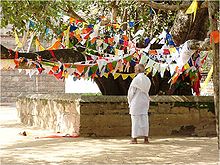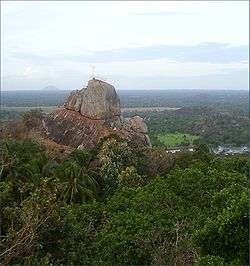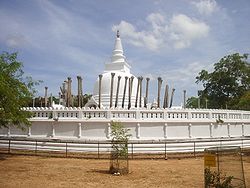- Devanampiya Tissa of Sri Lanka
-
Devanampiya Tissa King of Anuradhapura 
The Sri Maha Bodhi is said to have been brought to Sri Lanka during Devanampiya Tissa's reign. It is a sapling of the bo tree under which the Buddha attained enlightenment, and is symbolic of the most significant event of Tissa's reign - his conversion to BuddhismReign 307 BC – 267 BC Died 267 BC Predecessor Mutasiva Successor Uttiya Consort Anula Royal House Vijaya Father Mutasiva Tissa, later Devanampiya Tissa was one of the earliest rulers of Sri Lanka based at the ancient capital of Anuradhapura from 307 BC to 267 BC. His reign was notable for the arrival of Buddhism in Sri Lanka under the aegis of Mauryan Emperor Ashoka. The primary source for his reign is the Mahavamsa, which in turn is based on the more ancient Dipavamsa.
Contents
Reign
Tissa was the second son of Mutasiva, king of Anuradhapura. The Mahavamsa describes him as being 'foremost among all his brothers in virtue and intelligence'[2]. He ascended to the throne of the northern kingdom based at Anuradhapura sometime around 247 BCE[1]. The majority of his subjects were Pagan, as they had been since the arrival of the first Sinhala colonists on the island around 300 years previously.
The Mahavamsa mentions an early friendship with Mauryan Emperor Ashoka. Chapter IX of the chronicle mentions that '...the two monarchs, Devanampiyatissa and Dhammasoka, already had been friends a long time, though they had never seen each other', 'Dhammasoka' being an alternate way of saying 'Ashoka'. The chronicle also mentions Tissa sending gifts to the mighty emperor of the Maurya; in reply Ashoka sent not only gifts but also the news that he had converted to Buddhism, and a plea to Tissa to adopt the faith as well. The king does not appear to have done this at the time, instead adopting the moniker 'Devānaṃ-piya' ('Beloved of the Gods')[2] and having himself consecrated King of Lanka in a lavish celebration.
Devanampiyatissa is traditionally said to have been succeeded by his younger brothers Uttiya and Mahasiva.
Conversion to Buddhism
Emperor Ashoka took a keen interest in the propagation of Buddhism across the known world, and it was decided that his son, Mahinda, would travel to Sri Lanka and attempt to convert the people there. The events surrounding Mahinda's arrival and meeting with the king form one of the most important legends of Sri Lankan history.
According to the Mahavamsa king Devanampiyatissa was out enjoying a hunt with some 40,000 of his soldiers near a mountain called Missaka. The date for this is traditionally associated with the full moon day of the month of Poson.
Having come to the foot of Missaka, Devanampiyatissa chased a stag into the thicket, and came across Mahinda (referred to with the honorific title Thera); amusingly the Mahavamsa has the great king 'terrified' and convinced that the Thera was in fact a 'yakka', or demon. However, Thera Mahinda declared that 'Recluses we are, O great King, disciples of the King of Dhamma (Buddha) Out of compassion for you alone have we come here from Jambudipa'. Devanampiyatissa recalled the news from his friend Ashoka and realised that these are missionaries sent from India. Thera Mahinda went on to preach to the king's company and preside over the king's conversion to Buddhism.
Notable locations
Given the extremely early date of Devanampiyatissa's reign, the dearth of sources, and the impossibility of archeological inquiry due to current political instability, it is difficult to discern what impact this conversion had, in practical terms, on Devanampiyatissa's reign. For example whilst there are references to a Tissamahavihara and various other temples constructed by the king, none can be reliably located.
What is fairly certain however is that the site of his initial meeting with Thera Mahinda is one of Sri Lanka's most sacred sites today, going by the name Mihintale. The sacred precinct features the Ambasthala, or 'Mango tree stupa', where the Thera Mahinda asked Mahinda a series of riddles to check his capacity for learning [3], the cave in which Thera Mahinda lived for over forty years, and the Maha Seya, wherein is contained a relic of the Buddha.
The other major site associated with Devanampiyatissa's reign is the Sri Maha Bodhi in Anuradhapura. The tree was yet another of Emperor Ashoka's gifts to the island and was planted within the precincts of Anuradhapura, and is regarded as the oldest tree in the world.
Significance
Devanampiyatissa remains one of early Sri Lanka's most significant monarchs, given that his conversion to Buddhism set the kingdoms of the island down a religious and cultural route quite distinct from that of the subcontinent to the north. Later monarchs were to refer back to Devanampiyatissa's conversion as one of the cornerstones of the Anuradhapuran polity. The city itself was to remain capital of a powerful kingdom until the early Middle Ages, when it was eventually subsumed under the Chola invasion and then superseded by Polonnaruwa
See also
- Mahavamsa
- List of monarchs of Sri Lanka
- History of Sri Lanka
- Buddhism in Sri Lanka
- Mahinda
- Asoka
- Mihintale
Notes
- ^ [1]
- ^ See, e.g., Keown, Hodge & Tinti (2003), p. 72, entry for 'Devānampiya Tissa,' where it is translated as 'dear to the gods'.
References
- Keown, Damien, Stephen Hodge & Paola Tinti (2003). A Dictionary of Buddhism. Oxford University Press. ISBN 0198605609.
External links
- Mihintale
- The Maha Bodhi
- The Mahavamsa History of Sri Lanka The Great Chronicle of Sri Lanka
- Kings & Rulers of Sri Lanka
- Codrington's Short History of Ceylon
Devanampiya Tissa of Sri LankaVijayaBorn: ? ? Died: ? ?Regnal titles Preceded by
MutasivaKing of Anuradhapura Succeeded by
UttiyaMonarchs of the Anuradhapura Kingdom House of Vijaya
(477 BC-237 BC, 215 BC–205 BC)Chola invaders
(237 BC–215 BC, 205 BC–161 BC)Sena and Guttika (237 BC-215 BC) • Elara (205 BC-161 BC)House of Vijaya
(161 BC–103 BC)Dutthagamani (161 BC-137 BC) • Saddha Tissa (137 BC-119 BC) • Thulatthana (119 BC-119 BC) • Lanja Tissa (119 BC-109 BC) • Khallata Naga (109 BC-104 BC) • Valagamba (104 BC-103 BC)The Five Dravida
(103 BC–89 BC)Pulahatta (103 BC-100 BC) • Bahiya (100 BC-98 BC) • Panya Mara (98 BC-91 BC) • Pilaya Mara (91 BC-90 BC) • Dathika (90 BC-88 BC)House of Vijaya
(89 BC–66 AD)Valagamba (89 BC-76 BC) • Mahakuli Mahatissa (76 BC-62 BC) • Chora Naga (62 BC-50 BC) • Kuda Tissa (50 BC-47 BC) • Siva I (47 BC-47 BC) • Vatuka (47 BC-47 BC) • Darubhatika Tissa (47 BC-47 BC) • Niliya (47 BC-47 BC) • Anula (47 BC-42 BC) • Kutakanna Tissa (42 BC-20 BC) • Bhatikabhaya Abhaya (20 BC-9 AD) • Mahadathika Mahanaga (9-21) • Amandagamani Abhaya (21-30) • Kanirajanu Tissa (30-33) • Chulabhaya (33-35) • Sivali (35-35) • Interregnum (35-38) • Ilanaga (38-44) • Chandamukha (44-52) • Yassalalaka (52-60) • Subharaja (60-66)House of Lambakanna I
(66–436)Vasabha (66-110) • Vankanasika Tissa (110-113) • Gajabahu I (113-135) • Mahallaka Naga (135-141) • Bhatika Tissa (141-165) • Kanittha Tissa (165-193) • Cula Naga (193-195) • Kuda Naga (195-196) • Siri Naga I (196-215) • Voharika Tissa (215-237) • Abhaya Naga (237-245) • Siri Naga II (245-247) • Vijaya Kumara (247-248) • Sangha Tissa I (248-252) • Siri Sangha Bodhi I (252-254) • Gothabhaya (254-267) • Jettha Tissa I (267-277) • Mahasena (277-304) • Sirimeghavanna (304-332) • Jettha Tissa II (332-341) • Buddhadasa (341-370) • Upatissa I (370-412) • Mahanama (412-434) • Soththisena (434-434) • Chattagahaka Jantu (434-435) • Mittasena (435-436)The Six Dravidas
(436–463)Pandu (436-441) • Parindu (441-441) • Khudda Parinda (441-447) • Tiritara (447-447) • Dathiya (447-450) • Pithiya (450-452)House of Moriya
(463–691)Dhatusena (463-479) • Kashyapa I (479-497) • Moggallana I (497-515) • Kumara Dhatusena (515-524) • Kittisena (524-524) • Siva II (524-525) • Upatissa II (525-526) • Silakala Ambosamanera (526-539) • Dathappabhuti (539-540) • Moggallana II (540-560) • Kittisiri Meghavanna (560-561) • Maha Naga (561-564) • Aggabodhi I (564-598) • Aggabodhi II (598-608) • Sangha Tissa II (608-608) • Moggallana III (608-614) • Silameghavanna (614-623) • Aggabodhi III (623-623) • Jettha Tissa III (623-624) • Aggabodhi III (624-640) • Dathopa Tissa I (640-652) • Kashyapa II (652-661) • Dappula I (661-664) • Dathopa Tissa II (664-673) • Aggabodhi IV (673-689) • Unhanagara Hatthadatha (691-691)House of Lambakanna II
(691-1017)Manavanna (691-726) • Aggabodhi V (726-732) • Kashyapa III (732-738) • Mahinda I (738-741) • Aggabodhi V (741-781) • Aggabodhi VII (781-787) • Mahinda II (787-807) • Dappula II (807-812) • Mahinda III (812-816) • Aggabodhi VIII (816-827) • Dappula III (827-843) • Aggabodhi IX (843-846) • Sena I (846-866) • Sena II (866-901) • Udaya I (901-912) • Kashyapa IV (912-929) • Kashyapa V (929-939) • Dappula IV (939-940) • Dappula V (940-952) • Udaya II (952-955) • Sena III (955-964) • Udaya III (964-972) • Sena IV (972-975) • Mahinda IV (975-991) • Sena V (991-1001) • Mahinda V (1001-1017)Italics indicate regent. Categories:- Kings of Sri Lanka
- Sinhalese people
- 247 BC births
- 207 BC deaths
- Converts to Buddhism
Wikimedia Foundation. 2010.


